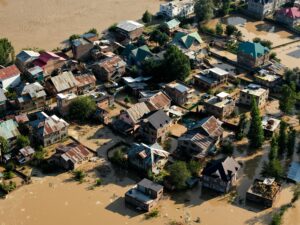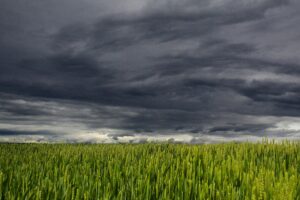What the Punjab Floods Teach Us About the Impact of Climate Change on Agriculture?
Agriculture has always been the heartbeat of the earth, from the beginning of human civilization to today. But imagine, when this heartbeat becomes irregular, won’t the whole body be affected? This is the situation of global agriculture today. Climate change has put agriculture in such a dilemma that every season comes as a new test for the farmer. The recent devastating floods in Punjab, India are a living example of this changing reality. This was not just a regional disaster, but a warning at the global level that if we do not wake up now, the food crisis, farmer’s suffering and inequality will deepen in the coming years. This is why now the question has become crucial: what is the actual impact of climate change on agriculture and what will we need to do in order to make future farming safe.

How Is Climate Change Altering Global Agriculture?
The world has achieved tremendous progress in industry and technology in the last couple of decades, but the biggest threat to humanity has turned out to be climate change. Climate change takes its biggest hit on the agricultural industry. Heavy rains, extended droughts, sudden temperature spikes, and frequent floods are becoming the new norm.
If there is no rainfall for months in the African Sahel region, only tales of famine are conceived on the desolate soil. On the other hand, Europe’s grapevines and wheat ears are repeatedly facing heatwaves. In Asia, especially South Asia, floods and cyclones have now become a part of almost every year. These incidents may seem to be stories of different geographical areas, but in reality, they all testify to the same truth that climate change has made agriculture synonymous with uncertainty.
The report makes this truth even clearer. According to it, global agricultural productivity has declined by about 21% in the last 60 years due to extreme weather events. Just think, this is not just a statistic, but the shattering of dreams of lakhs of farmers and the emptying of plates of crores of people.
Its impact is not limited to the farm boundary. When crops are destroyed in a country, their direct impact is seen in the international market. Prices rise, and the burden falls first on the people of poor and developing countries. The World Bank has already warned that if this situation continues, more than 130 million people may fall under the ambit of food insecurity by 2030.
It is obvious that the impact of climate change on agriculture is not something far away, but it is in today’s world. And the world makes one believe that in the years to come, agriculture will not only be a profession of cultivating food, but will also demand guts to combat the uncertainties of the impact of climate change on agriculture.
What do the Punjab floods tell us about future farming risks?
Punjab, India’s traditional granary, has always been the cornerstone of the nation’s food security. But the recent floods that ravaged the state made it apparent that the impact of climate change on agriculture into a new age of insecurity. The Punjab Flood in India was not only a natural calamity, but an alarm call that if things do not change, agriculture will remain in crisis.
A look at the figures and the picture becomes even more frightening.
- About 2,185 villages were submerged (Times of India, 2025).
- About 3.5 lakh people were affected (BBC, 2025).
- More than 4.8 lakh acres of crops were destroyed, including 30,000 acres of cotton (Times of India, 2025).
But these are not just numbers. Behind every number is a human being, a family, and its livelihood. Just imagine, when the farmer who had planted paddy by sweating in the scorching sun sees that his entire field has been washed away in the flood, it is not just an economic loss for him, but the biggest blow of his life.
The Punjab floods have made one more thing clear: the future of farming is now directly in the grip of climate change. The impact of climate change on agriculture is visible everywhere:
- Sometimes, excessive rainfall ruins both sowing and harvesting.
- Sometimes long droughts push the groundwater level further down.
- Events like floods and hailstorms destroy both the fertility of the soil and production.
- The debt burden on farmers increases, and they get caught in a mental and financial crisis.
In fact, this flood tells us that the impact of climate change on agriculture in India is no longer just a fear of the future, but the harsh reality of the present. When even a prosperous state like Punjab grapples with this disaster, it is a message for the entire country and the world that agriculture has now become a prisoner of the uncertainties of climate.
The villages submerged in the fields do not just depict the picture of one state, but are a reflection of the global crisis, where every farmer is wondering whether the next crop will be safe or will it also fall prey to some uncontrolled disaster?
What Major Challenges Does The Impact of Climate Change on Agriculture Have Around The Globe?
Agriculture has long followed the natural cycles of the environment. If the rains are timely, the temperature is regulated, and the land holds its vigour, then only the farmer can be sure that his toil will bear fruit. But today this confidence is constantly wavering. The mood of the weather has become so uncertain that the farmer enters the field considering every season as a gamble.

Floods and irregular rainfall
In the last few years, the nature of rain has completely changed. At times it doesn’t rain for months, and then suddenly when the clouds burst, the fields become waterlogged. The floods not only devastate the crops but also deprive the soil of its fertility. We observed the same spectacle during the recent Punjab floods where green fields were converted into mud and water within minutes.
Drought and water shortage
On the other end, there is the wrath of drought. From Africa to Asia, farmers are left staring at thirsty fields. Groundwater is continuously going down, and irrigation is becoming expensive and difficult day by day. Small farmers are paying the heaviest price for this crisis.
Increasing outbreak of diseases and pests
The warm climate has given an opportunity for pests and diseases to flourish. The pests that were earlier limited to certain areas are now spreading to new places. The biggest example of this is the attack of locusts, which has destroyed the crops of many countries in recent years.
Decreasing yield
The yield of agriculture is gradually decreasing. Assessments of international organizations show that global agricultural productivity has declined significantly in the last three decades. This decline is not just a figure, but a direct impact on the reduction in the income of millions of farmers and the plates of crores of people.
Food security and inflation
When the crop is less, the grain becomes expensive. Rich countries have options, but the people of poor and developing countries have to bear both inflation and hunger. This is the reason why the impact of climate change on agriculture is no longer just an issue for farmers, but has become a concern for every household.
It is clear that this uncertainty of the weather has brought farming to a difficult phase. The impact of climate on agriculture is visible at every level, from farm to plate. And when agriculture is shaken, society, economy, and future generations also become vulnerable.
What lessons do we learn from the Punjab floods?
The Punjab floods have made it clear that the impact of climate change is no longer limited to just one state, but it is a danger signal for agriculture all over the world. The submerged villages and ruined crops teach us five big lessons.
Crop diversity is the shield for agriculture
Wheat and rice cultivation dominated Punjab. The floods devastated both simultaneously. This shows that sticking to one type of crop is the biggest risk. Adopting a variety of crops can reduce the impact of the crisis.
A strong drainage system is essential
It is not possible to stop rain and floods, but their impact can be reduced. The tragedy of Punjab clearly showed that the drainage and canal system was weak. Better water management has now become a prerequisite for saving agriculture.
Timely help is the real relief
Farmers whose crops were submerged had to wait for help. This experience shows that relief and insurance are meaningful only when they reach the farmer immediately. Help received late is often useless.
Farmers must be prepared for changing weather
Farmers are diligent, but weather is no longer as consistent as it used to be. The flood has depicted the significance of furnishing weather forecasts in time, updated equipment, and scientific guidance to farmers. These will empower them to confront such calamities. For more details visit our website and stay updated.
Protection of soil and water is the real security
Crops can be planted again, but after the fertility of the land and availability of water decline, they are hard to manage. The Punjab floods demonstrated that agriculture has its roots in these two resources, and saving them should be the largest concern.
This recent impact of climate change on agriculture was not just a disaster, but a warning. If these lessons are adopted in time, then the coming generations will also be able to get assurance of the greenery of fields and the security of food grains.
Overall….
The Punjab floods have made it clear that the impact of climate change on agriculture is not just a matter of weather, but it is directly affecting our agriculture and food security. When fields get submerged, not only is the hard work of the farmer wasted, but the plate of every household is also affected. This is why the biggest responsibility today is to make agriculture strong and secure for the future.
The solutions are with us. Adopting diverse crops, protecting water and soil, providing correct information to farmers, and providing timely assistance can make agriculture resilient. This work is not of the farmer alone. Governments, society, and science will have to work together.
If we take steps in the right direction by being alert today, then the coming generations will also be able to see the greenery of the fields and the prosperity of food. If not, the next disaster will teach us harsher lessons.
